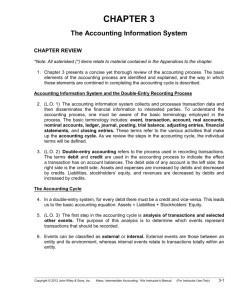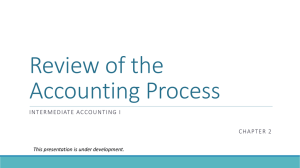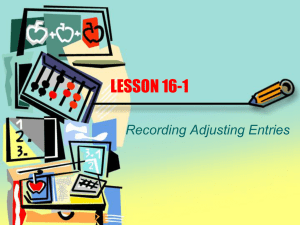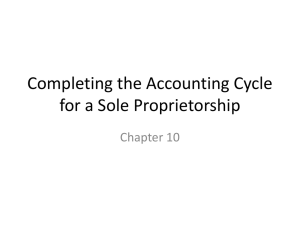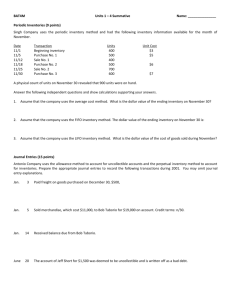Chapter 3
advertisement
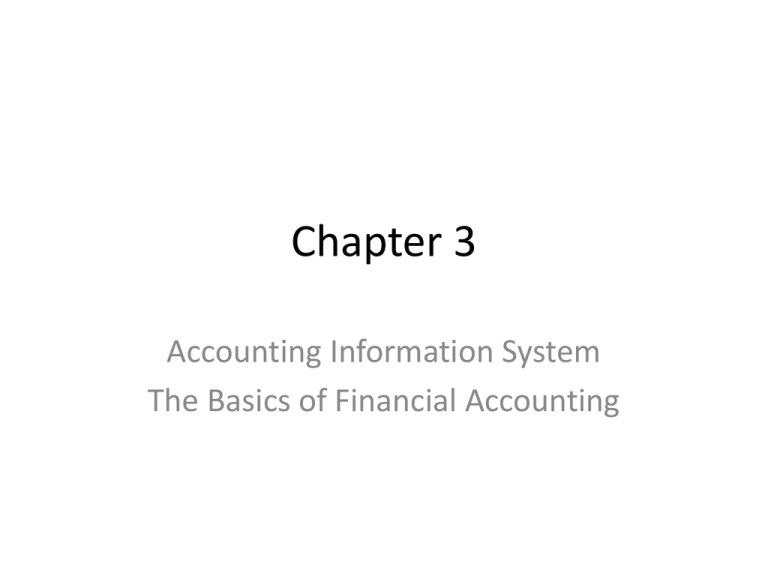
Chapter 3 Accounting Information System The Basics of Financial Accounting Accounting Information System Collects and processes transaction data. Disseminates information to interested parties. Terminology: event; transaction (external event with a transfer or exchange between entities); real (assets, liabilities & equity) and nominal (income statement + dividends) accounts. Accounting Process Journal (book of original entry, record of transactions) Posting to ledger (book of all accounts) Trial Balance Adjusting Entries (entries at the end of the period to bring all accounts up-to-date) Financial Statements Closing Entries (close nominal accounts to equity) Reversing Entries Double Entry Bookkeeping • The use of double entry bookkeeping invented by Medieval Italian merchants by 1200; described by Luca Pacioli’s Summa in 1494. • Double entry was essential to business success (and ultimately the Renaissance) in Italy, then the success of the Industrial Revolution in Britain and Northern Europe. • Charles Sprague invents the Algebra of Accounts in 1880: Debits = Credits; Assets = Liabilities+ Equity; Revenues – Expenses = Earnings; ultimately: Assets – Liabilities + Common Stock + Retained Earnings – Dividends + Revenue – Expenses. Ownership Structure of a Corporation Common Stock Additional Dividends Paid-in Capital Declared (negative) Retained Earnings Treasury Stock (negative) Accounting Cycle • Transaction Journal Entry Post to Ledger Prepare Trial Balance Adjustments Adjusted Trial Balance Financial Statements Closing Entries Post-closing Trial Balance Reversing Entries Journalizing • General Journal – a chronological record of transactions. Journal Entries are recorded in the journal. Date Jan. 3 Account Title Cash Common stock 10 Building Note payable Ref. 100 Debit 100,000 300 130 220 Credit 100,000 150,000 150,000 Posting to Ledger • Posting – the process of transferring amounts from the journal to the ledger accounts. Cash Date Explanation Debit Credit Balance Jan. 3 Sale of Stock 100,000 100,000 Trial Balance Acct. No. 100 105 110 130 200 220 300 330 400 500 Account Cash Accounts receivable Inventory Building Accounts payable Note payable Common stock Retained earnings Sales Cost of goods sold Debit Credit $ 140,000 35,000 30,000 150,000 $ 60,000 150,000 100,000 75,000 30,000 $ 385,000 $ 385,000 Adjusting Entries Revenues - recorded in the period in which they are earned. Expenses - recognized in the period in which they are incurred or (and/or matched to revenues). Adjusting entries - needed to ensure that the revenue recognition and matching principles are followed. Types of Adjusting Entries • Prepayments: Prepaid Expense (expenses paid but not yet used) Unearned Revenue (cash received but revenue not yet earned) Accruals: Accrued Revenue (earned but cash not yet received) Accrued Expense (incurred but not yet paid) Adjustments: Prepaid Expenses • Payment of cash that is recorded as an asset because service or benefit will be received in the future. Prepayments often occur in regard to: Insurance Rent Supplies Maintenance on Equipment Advertising Fixed Assets Adjustments: Prepaid Expenses • Example: On Jan. 1st, Phoenix Corp. paid $12,000 for 12 months of insurance coverage. Show the journal entry to record the payment on Jan. 1st. Jan. 1 Prepaid Insurance 12,000 Cash 12,000 Adjustments: Prepaid Expenses • Show the adjusting journal entry required at Jan. 31st. Jan. 31 Insurance Expense 1,000 Prepaid Insurance 1,000 Adjustments: Unearned Revenue • Receipt of cash that is recorded as a liability because the revenue has not been earned. • Unearned revenues often occur in regard to: Rent Magazine Subscriptions Airline Tickets Customer Deposits School Tuition Prepaid Software Adjustments: Accrued Revenue • Revenues earned but not yet received in cash or recorded. • Examples: Rent Interest Services Performed Adjustments: Accrued Expenses • Expenses incurred but not yet paid in cash or recorded. • Examples: Rent Salaries Interest Bad Debts Taxes Trial Balance and Financial Statements • Adjusted Trial Balance: Shows the balance of all accounts, after adjusting entries, at the end of the accounting period. • Financial Statements are prepared directly from the Adjusted Trial Balance: Balance Sheet; Income Statement; Cash Flow Statement; Statement of Stockholders’ Equity Closing Entries To reduce the balance of the income statement (revenue and expense) accounts to zero. [Income statement items are nominal (temporary) accounts that are eliminated at the end of the accounting period.] To transfer net income or net loss to owner’s equity. Balance sheet (asset, liability, and equity—permanent accounts) accounts are not closed. Dividends are closed directly to the Retained Earnings account. Perpetual Inventory System Inventory account increased with each purchase. Inventory account reduced and Cost of Goods Sold account increased with each sale. Balance in Inventory account should equal inventory amount on hand. No Adjusting Entries should be needed. Physical inventory performed to confirm balance in Inventory account. Periodic Inventory System Inventory account remains unchanged during period. Purchases account increased with each purchase. • At end of accounting period: Purchases account closed. Inventory account adjusted to physical count. Reversing Entries • Reversing entries is an optional step that a company may perform at the beginning of the next accounting period.


